To draft a bill of sale for a vehicle, gather all vehicle details like make, model, VIN, and condition, as well as buyer and seller contact info. Decide on the sale price and payment terms, then write clear purchase details, including any warranties or exclusions. Make certain to include signatures and notarization if needed. Keep copies for your records and verify compliance with local laws—if you continue, you’ll learn more about each essential step.
Key Takeaways
- Gather all vehicle details (make, model, VIN, mileage) and buyer/seller contact information for accurate documentation.
- Define sale terms, price, payment methods, and legal considerations, including warranties and transfer regulations.
- Draft a clear vehicle description, including condition, damages, modifications, and registration status.
- Obtain signatures and notarization if required, ensuring all parties sign in the presence of a notary public.
- Distribute copies of the completed bill of sale, keep records, and ensure compliance with state-specific legal requirements.
Gather Necessary Information About the Vehicle
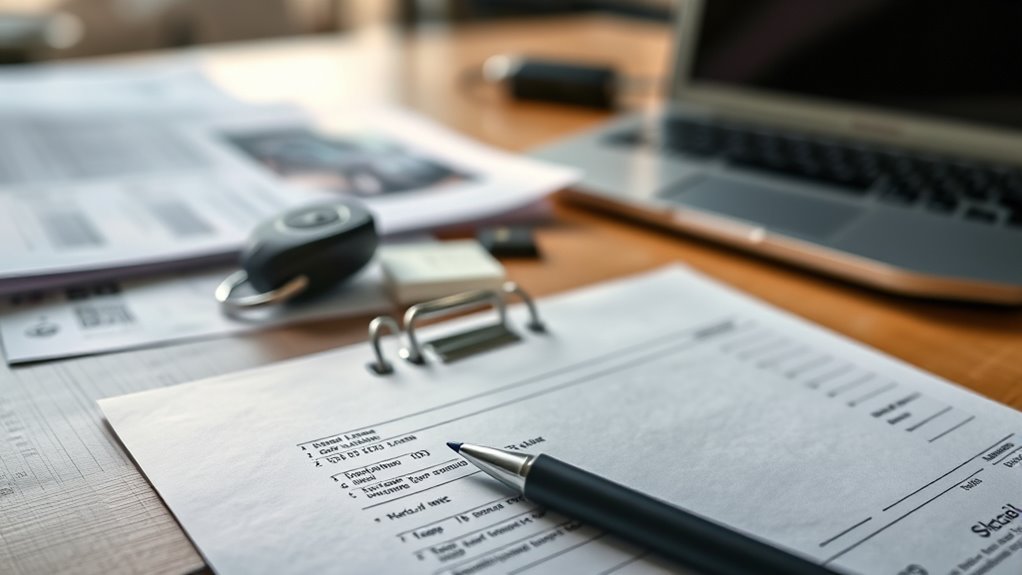
Have you gathered all the essential details about the vehicle? It’s vital to collect information like the vehicle’s make, model, year, VIN, and current odometer reading. You’ll also need to confirm the vehicle’s registration status to verify it’s properly registered and up-to-date. This helps verify ownership and prevents future disputes. Don’t forget to check the insurance requirements; guarantee the vehicle has valid insurance coverage that meets local laws. Gathering these details upfront makes the drafting process smoother and guarantees your bill of sale includes accurate information. Having everything documented correctly protects both buyer and seller and streamlines the transfer process. Make certain all vehicle registration and insurance details are current and accurate before moving forward.
Collect Details of the Buyer and Seller

You need to gather accurate personal information from both the buyer and seller to make certain the bill of sale is valid. Make sure to verify contact details so you can easily reach either party if needed. Precise information helps prevent future disputes and keeps the transaction clear. Additionally, confirming the for sale status ensures the vehicle’s ownership and sale terms are legitimate.
Gather Personal Information
Gathering personal information is a crucial first step in drafting a vehicle bill of sale. You need to collect details from both the buyer and seller, including full names, addresses, and contact numbers. This information guarantees the document is legally valid and helps in the vehicle registration process. Make sure you have the title transfer details, such as the vehicle identification number (VIN), make, model, and year. Accurate personal information is indispensable to avoid future disputes and to verify identities. Confirm that the seller’s name matches the name on the title, and gather the buyer’s details for proper registration. Properly documenting these details guarantees a smooth transfer of ownership and helps authorities process the vehicle registration efficiently.
Verify Contact Details
To make certain the vehicle transfer goes smoothly, verifying contact details of both the buyer and seller is essential. Contact verification ensures you have accurate information, reducing the risk of misunderstandings or fraud. Confirm each party’s full name, phone number, and email address, and ask for official identification if needed. Address confirmation is also vital; verify the current residential addresses to ensure proper documentation and legal compliance. Double-check these details against official IDs or utility bills to avoid discrepancies. Accurate contact details help facilitate smooth communication during the transfer process, and address confirmation ensures proper legal and contractual procedures. Additionally, considering hydrotherapy benefits or other water-related health amenities can promote wellness during the process. Taking these steps minimizes errors and guarantees both parties are easily reachable throughout the transaction.
Decide on the Sale Terms and Price
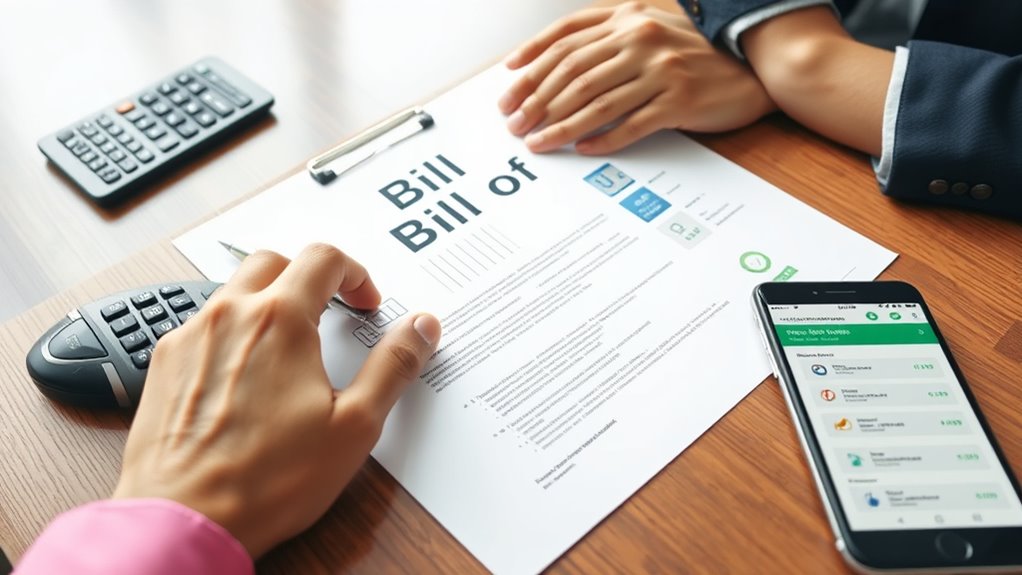
Deciding on the sale terms and price is a crucial step to guarantee both parties agree on the transaction. You need to clearly define the agreed-upon price and how payment will be made. Consider these key points:
- Choose payment options that work for both, such as cash, check, or electronic transfer.
- Discuss financing arrangements if the buyer needs a loan or installment plan.
- Set the conditions for deposits, full payment, and potential escrow services.
- Ensure that the payment process aligns with the projector technology used, such as digital transfers for high-resolution transactions.
Draft the Bill of Sale Document

When drafting the Bill of Sale, you need to include essential document components, such as vehicle details and buyer and seller information. Make sure all vehicle information is accurate to prevent future disputes. Clear identification of both parties is vital for a valid and enforceable agreement. Incorporating certifications and endorsements from beauty experts can enhance the credibility of the transaction, ensuring all parties trust the process.
Essential Document Components
A well-crafted vehicle bill of sale must include several essential components to guarantee clarity and legal enforceability. These components ensure both parties understand the transaction details and protect your interests. First, you should clearly state the vehicle’s basic information, such as make, model, year, and VIN, along with its vehicle history. Second, include the sale price and any financing options, specifying payment terms if applicable. Third, make sure to record the date of sale, buyer and seller details, and signatures to formalize the agreement. These elements help prevent misunderstandings and provide legal proof of the transaction. Including accurate vehicle details and financing options ensures the document is complete and ready for any future reference or legal requirements. A thorough understanding of legal documentation is essential to drafting a valid bill of sale.
Accurate Vehicle Details
How can you guarantee the vehicle details in your bill of sale are accurate? Start by double-checking the vehicle registration, which provides essential info like the VIN, make, model, and year. Carefully verify the license plates to ensure they match the registration details and haven’t been altered. It’s vital to cross-reference this information with the seller’s documentation to prevent mistakes. Accurate vehicle details help avoid future disputes and ensure the transfer process runs smoothly. Be meticulous in recording the correct VIN, engine number, and registration status. If any details are unclear, ask the seller for official documents. Precise, verified information makes your bill of sale reliable and legally sound, protecting both parties during and after the transaction.
Clear Buyer and Seller Information
Accurate vehicle details set a solid foundation for your bill of sale, but ensuring the document clearly identifies the parties involved is just as important. You need to include full names, addresses, and contact information for both the buyer and seller. This helps avoid confusion and makes the transfer official. Additionally, double-check that the buyer’s vehicle registration details match the information provided. Meeting licensing requirements ensures the sale complies with local laws, making it easier to transfer ownership smoothly. Incorporating proper documentation and verifying all details can prevent legal issues later on.
Include a Detailed Description of the Vehicle
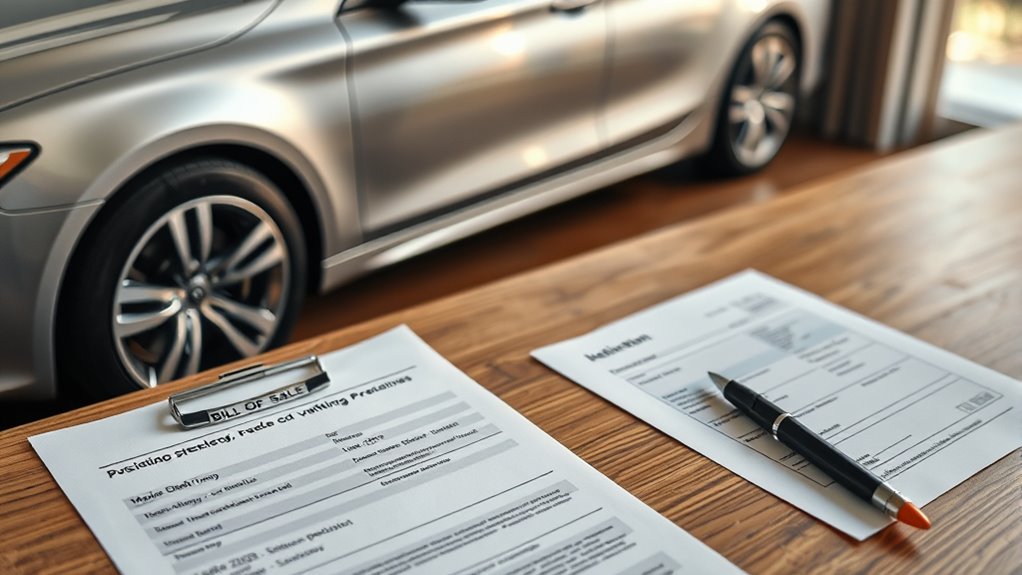
Providing a clear and detailed description of the vehicle is essential to guarantee both parties understand exactly what’s being sold. Include specifics such as the make, model, year, color, and Vehicle Identification Number (VIN). Mention the current vehicle registration status and verify it matches the details in the bill of sale. Refer to the insurance documentation to confirm the vehicle’s coverage and ownership status. Listing the odometer reading at the time of sale helps prevent future disputes. Also, note any existing damages or modifications that could affect the vehicle’s value. Accurate information minimizes misunderstandings and provides legal clarity. Remember, the more precise your description, the smoother the transfer process will be for both parties involved. Incorporating industry transformations can help ensure the process remains compliant with current regulations and standards.
Clearly State the Sale Conditions and Warranties

After detailing the vehicle’s specifics, it’s important to explicitly outline the sale conditions and any warranties. This helps prevent misunderstandings and protects both parties. Make sure to clearly state any warranty clauses, such as coverage period, what’s included, and any limitations. Also, specify the sale conditions, including payment terms, transfer of ownership, and delivery arrangements. Here are some key points to include: 1. Define any warranty clauses, including duration and scope. 2. Clarify sale conditions, like payment methods and deadlines. 3. State any exclusions or limitations related to warranties or sale terms. Being precise guarantees both you and the buyer understand your responsibilities and rights, making the transaction smoother. Additionally, specifying toilet maintenance and potential issues in the warranty can help manage expectations and reduce future disputes.
Review State-Specific Requirements and Legal Language
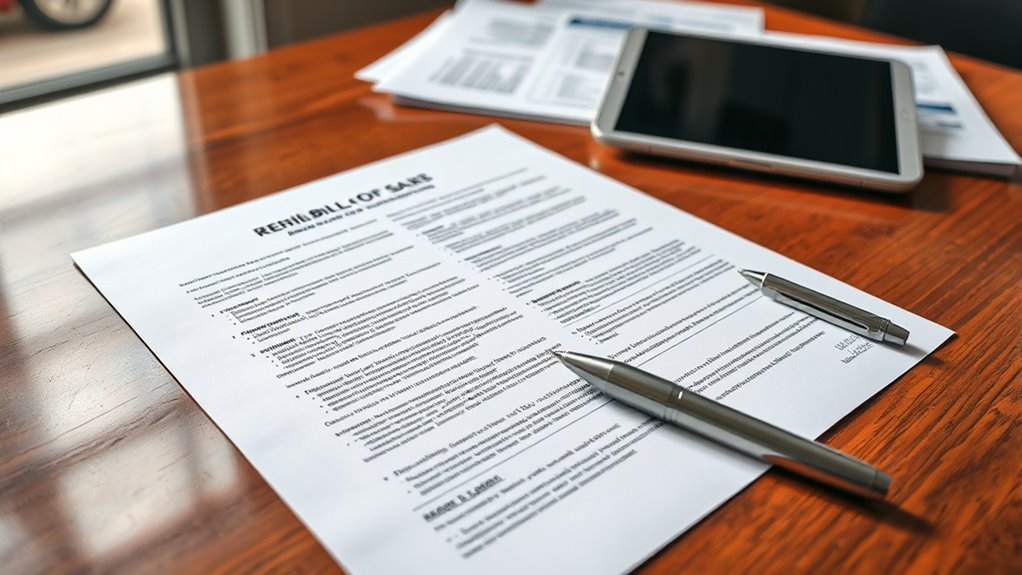
Have you checked your state’s specific requirements for vehicle sales? It’s vital to review transfer laws to guarantee your bill of sale complies with legal standards. Different states may have unique wording or clauses necessary for a valid transfer, so double-check your state’s legal language. Additionally, understanding tax implications is essential; some states require specific statements to clarify whether sales tax has been paid or if it’s the buyer’s responsibility. Failing to meet these requirements can delay registration or lead to legal issues later. To avoid complications, consult your state’s DMV or legal resources to confirm that your bill of sale includes all mandated language and complies with transfer laws. This step helps protect both buyer and seller throughout the transaction. Understanding state-specific alimony laws can also be beneficial if your vehicle transfer is part of a divorce settlement.
Signatures and Notarization (If Required)
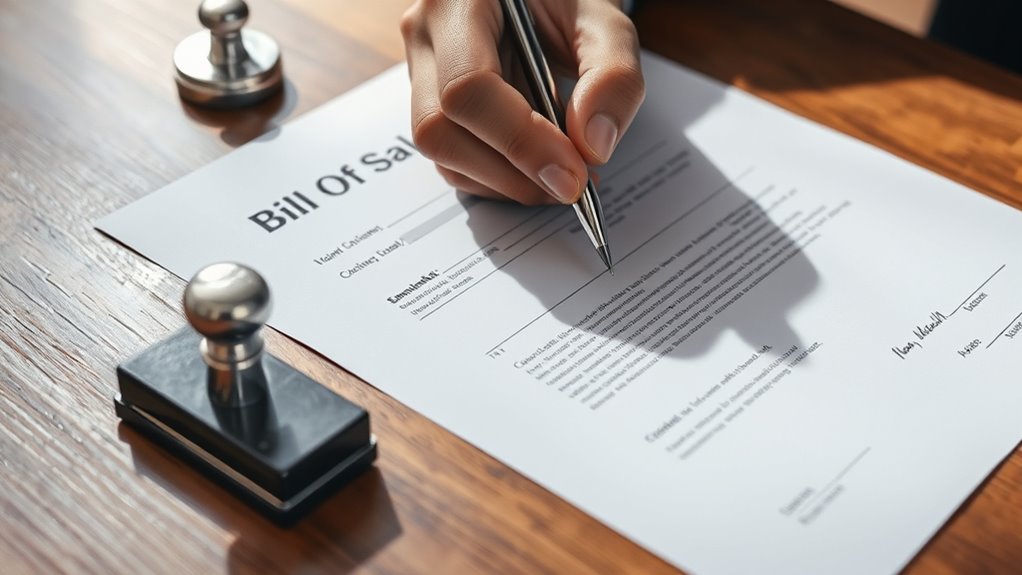
If your state requires notarization, guaranteeing the signatures are properly witnessed is essential to validate the bill of sale. Proper witness signatures and following notarization procedures help confirm the document’s authenticity. Here’s what you need to do:
- Find a qualified notary public who can witness the signatures and verify identities.
- Ensure all parties sign in front of the notary, who will then affix their official seal.
- Follow your state’s notarization procedures, which may include presenting valid ID and completing any necessary acknowledgment forms.
- Be aware that self-watering plant pots often feature a reservoir system that helps maintain consistent moisture, which can be useful knowledge if you’re including details about the vehicle’s condition or care requirements in the bill of sale.
These steps help prevent disputes later and make your bill of sale legally binding. Remember, notarization isn’t always required, but when it is, proper execution is key.
Distribute Copies and Keep Records

Why is it important to distribute copies of the bill of sale and keep detailed records? Distributing copies guarantees both you and the buyer have proof of the transaction, which is crucial if any disputes arise or for future vehicle inspections. Keeping detailed records, including the bill of sale and related loan documentation, helps you track ownership history and financial agreements. If the vehicle undergoes a vehicle inspection later, having these documents on hand proves legal ownership and transfer details. Additionally, retaining copies simplifies tax reporting and registration processes. Proper documentation also safeguards you in case of title claims or legal issues. Ensure each party receives a signed copy, and store your records securely for future reference. This practice streamlines legal compliance and protects your interests.
Frequently Asked Questions
Can I Use a Generic Bill of Sale Template for Any Vehicle?
You might think a generic template works for any vehicle, but it’s not always the best choice. Different vehicle types, like cars, boats, or motorcycles, often require specific details to be legally binding. Using a generic template could miss important info or vary by jurisdiction. To be safe, customize the template for your vehicle type or find one tailored to your specific needs, ensuring all legal requirements are met.
What Should I Do if the Buyer Refuses to Sign the Document?
If you face buyer refusal to sign the document, don’t get discouraged. You should calmly explain the importance of signing the bill of sale and try to address any concerns. If they still refuse, consider using alternative documentation, like a notarized statement or a written agreement, to prove the sale. Always keep records of your attempts to obtain signatures, as these can support your case later.
Are There Specific Warranties I Need to Include for Certain Vehicles?
When addressing warranties for a vehicle, you should clearly state the vehicle condition and include any warranty disclaimers. If certain vehicles come with specific warranties, mention those explicitly to protect yourself. For vehicles sold “as-is,” clearly state that no warranties are provided. This helps set proper expectations and reduces potential disputes, ensuring both parties understand the scope of the warranty coverage or disclaimers involved.
How Do I Handle a Sale Involving a Financed or Leased Vehicle?
Did you know over 30% of vehicle sales involve financed or leased vehicles? When handling such sales, you must include specific details in your bill of sale. For a financed vehicle, make certain the lienholder’s info is clear, and the loan payoff is documented. For a leased vehicle, verify lease transfer rights and include any residual value. Always communicate with lenders or leasing companies to avoid future disputes.
What Are the Consequences of Not Properly Notarizing the Bill of Sale?
Notarization importance lies in confirming your signature’s authenticity, which guarantees the bill of sale’s legal validity. If you don’t properly notarize it, the document might be challenged or deemed invalid in court. This can lead to delays in transferring ownership, difficulty in proving the sale, or even legal disputes. To protect yourself, always have the bill of sale notarized to ensure it’s legally recognized and enforceable.
Conclusion
Creating a thorough bill of sale guarantees a smooth vehicle transfer and legal protection. Did you know that 85% of vehicle disputes are resolved through proper documentation? By following these steps, you’ll minimize misunderstandings and safeguard your transaction. Keep copies of all documents, and consider notarization if required. With a clear, well-drafted bill of sale, you’ll confidently complete your vehicle sale, avoiding future complications and ensuring both parties are protected.









